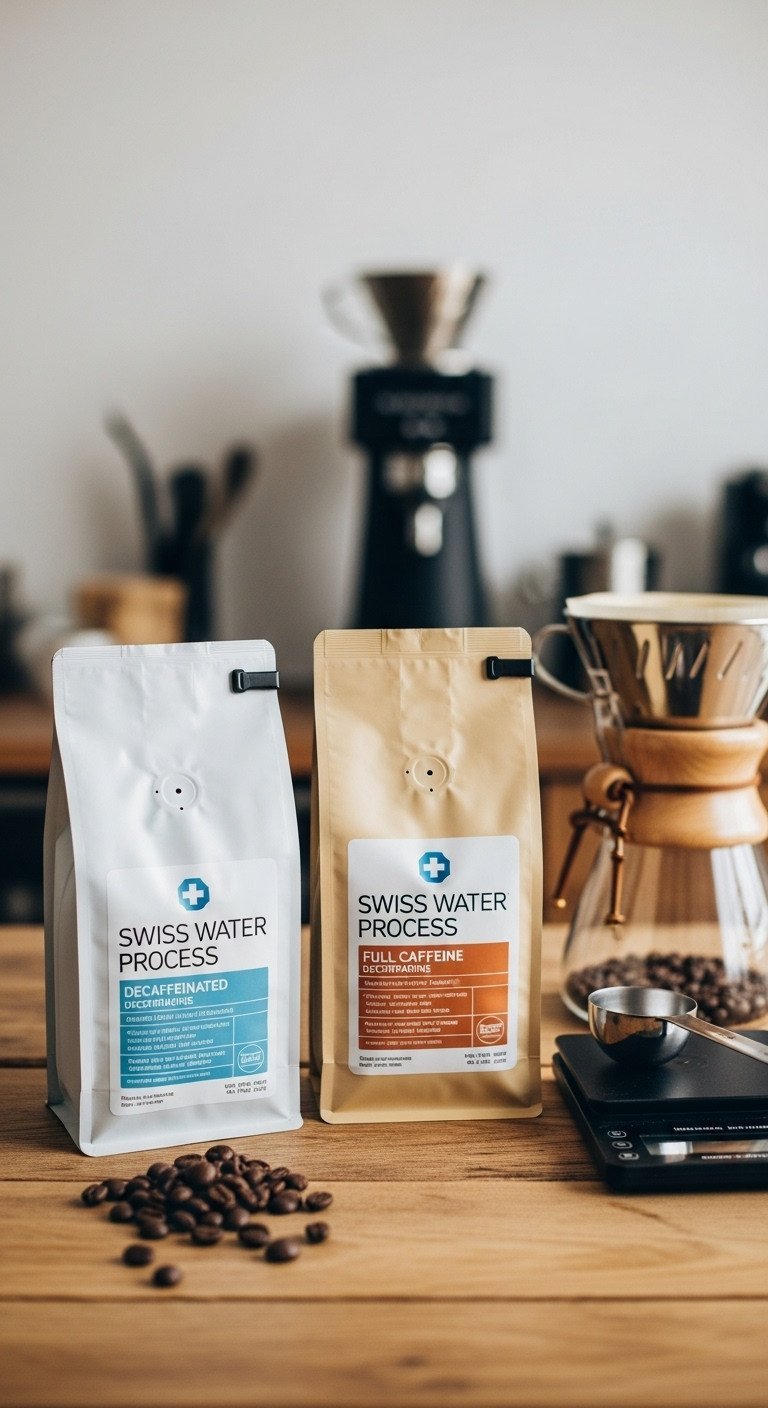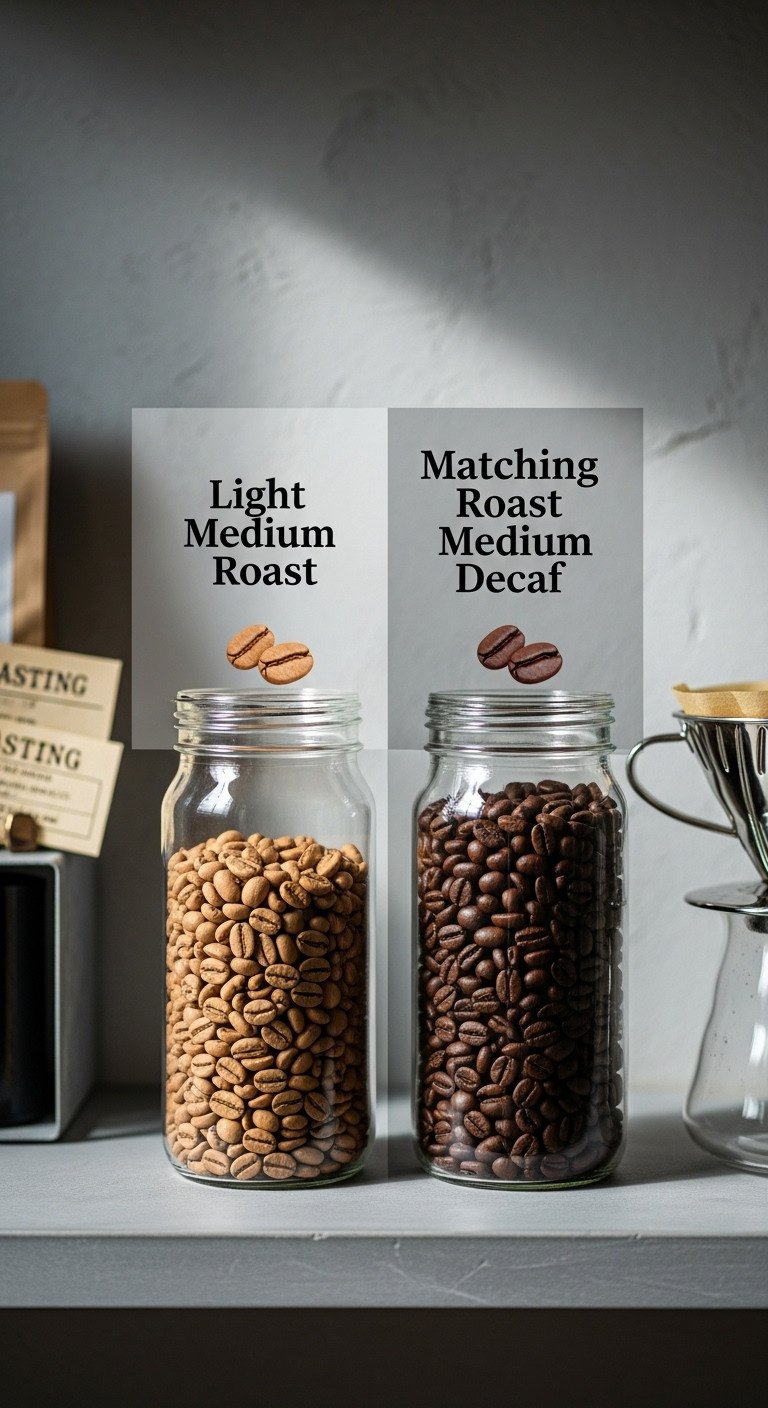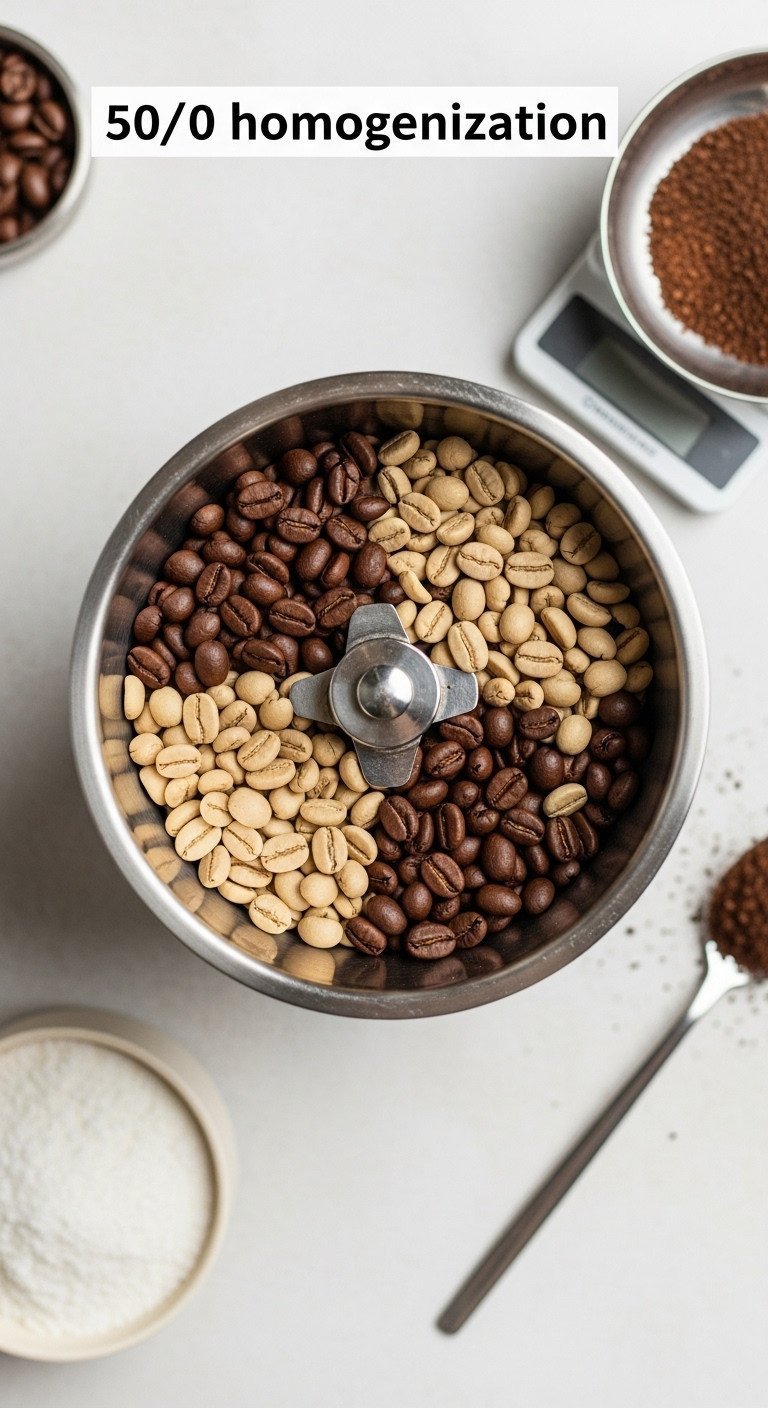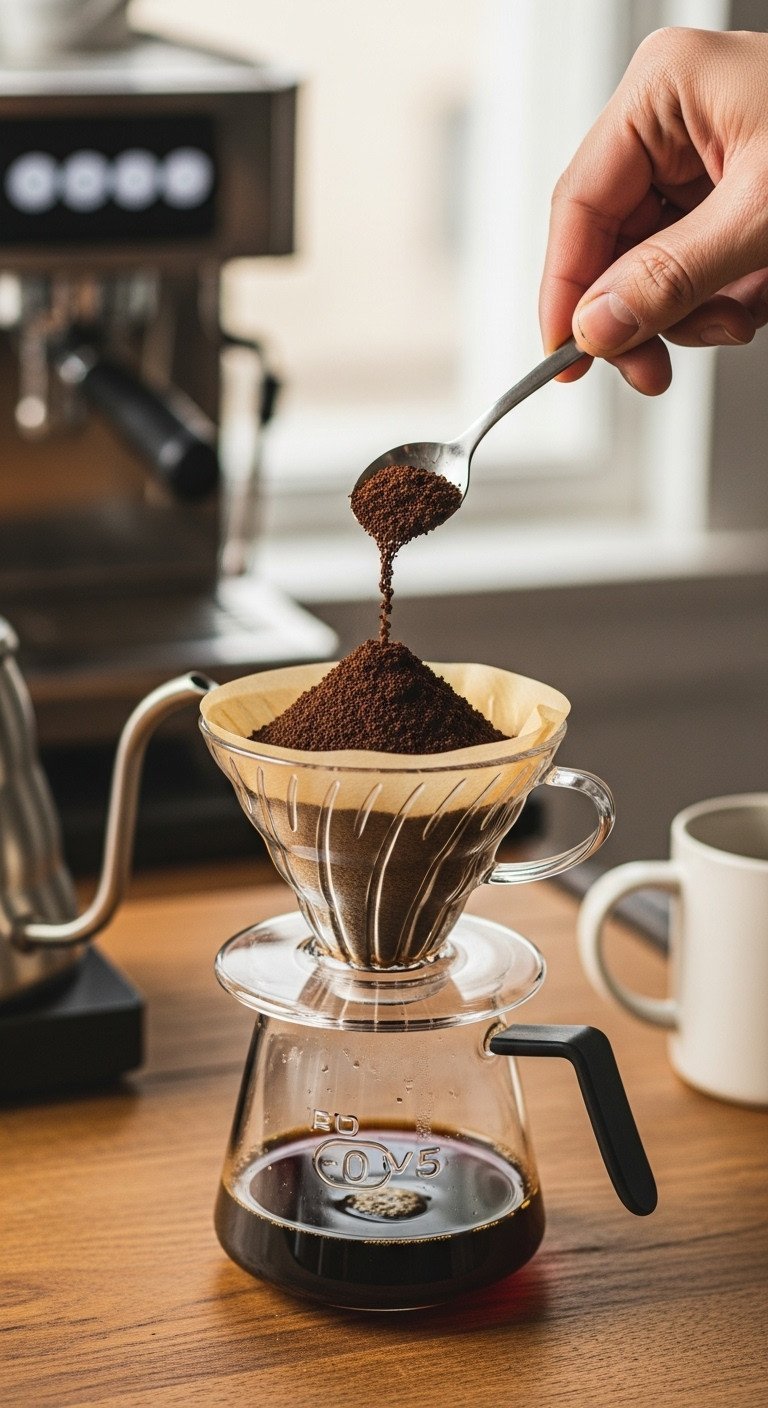As an Amazon Associate CoffeeXplore.com earns from qualifying purchases.
7 Secrets To Perfect Half Caff Coffee Jitters Free
Tired of your daily coffee ritual ending in a wave of anxiety? You love the taste, but the caffeine jitters are just too much.
This feeling of overstimulation is a common struggle. You’re looking for a way to enjoy your coffee without the unpleasant side effects. Half caff coffee is the concept of blending regular and decaf beans to achieve a balanced, reduced-caffeine brew.
Half caff coffee is the perfect solution for jitters and anxiety because it precisely cuts the stimulant dose by about 50% (typically 45-70 mg per cup). This guide will reveal the seven secrets to creating a perfectly smooth, flavorful, and anxiety-free half caff experience right at home. You’ll discover how to take back control of your coffee ritual.
Tired of the Jitters? Why Half Caff is Your Anxiety-Free Coffee Solution
Half caff coffee is the perfect solution for jitters, anxiety, and caffeine sensitivity because it precisely reduces the stimulant dose by half (typically 45-70 mg per cup). This moderation strategy allows you to maintain the ritual and flavor of coffee without triggering the acute adrenaline spikes associated with full-caffeine consumption.
For many, a cup of regular coffee delivers more stimulation than they need, leading to a cascade of unwanted effects: a racing heart, restlessness, and the dreaded afternoon crash. This is where the simple genius of a half decaf blend shines. It’s not about quitting coffee; it’s about mastering your dose.
By blending regular coffee with a high-quality decaf, you create a controlled, balanced beverage. This approach respects your body’s limits while still providing the comforting warmth and rich flavor you love. According to physiological studies, caffeine has a half-life of 4 to 6 hours. Switching to a half caff blend, especially in the afternoon, supports better sleep and healthier cortisol rhythms, making it an essential strategy for anyone looking to find a more peaceful relationship with their favorite drink.
7 Secrets To Perfect Half Caff Coffee Jitters Free
Achieving a truly perfect, jitters-free half caff coffee is about more than just mixing two types of coffee. It’s a craft that balances science and taste. These seven secrets go beyond the basic 50/50 blend, giving you the professional methodology needed for a consistently delicious and anxiety-free cup every single time. From selecting the right decaf to personalizing your ratio, each step is a crucial part of the process.
1. Prioritize Swiss Water Process Decaf (SWP) for Flavor Purity

Pin this genius tips to your ‘Coffee Secrets’ board!
The quality of your half caff blend is entirely dependent on the quality of its decaf component. Many decaffeination processes use chemical solvents that can strip flavor and leave behind an undesirable aftertaste. The Swiss Water Process (SWP) is a chemical-free method that uses only water to gently remove 99.9% of the caffeine, preserving the coffee’s delicate and complex flavor profile.
Materials Needed:
- High-Quality Regular Coffee Beans (medium roast recommended)
- Premium Decaf Beans (explicitly labeled Swiss Water Process or CO2 processed)
- Airtight Storage Canister
Step-by-Step Directions:
- Research Source: Before purchasing, verify that the decaf component uses a chemical-free method (SWP or CO2) to retain complex flavor profiles.
- Verify Freshness: Purchase both the regular and decaf beans from a reputable roaster with a ‘roasted on’ date within the last two weeks.
- Taste Test Decaf: Brew a small batch of the decaf component alone to ensure it has no off-flavors, as this component determines the floor of your half caff taste.
- Store Separately: Keep the two components stored individually in opaque, airtight containers until you are ready to blend them.
Pro-Tip: Chemical-processed decaf (like Methylene Chloride) can leave residual notes that surface when blending. SWP ensures a clean base, which is crucial for a smooth, jitters-free blend that doesn’t sacrifice taste.
2. Measure Beans by Weight, Not Volume, for Consistency

Save this clever organization idea!
The primary cause of unexpected jitters from a homemade half caff blend is an inconsistent ratio. Measuring beans with a scoop is highly inaccurate because the decaffeination process can alter a bean’s density. The only way to guarantee a true 50/50 blend every time is to measure by weight using a digital scale.
Materials Needed:
- Digital Coffee Scale (accurate to 0.1 gram)
- Regular Coffee Beans
- Decaf Coffee Beans
Step-by-Step Directions:
- Zero the Scale: Place your coffee canister or small bowl on the scale and press the TARE button to zero it out.
- Weigh Regular Beans: Add your regular coffee beans until the scale reads exactly 50% of your total desired dose (e.g., 10g for a 20g dose).
- Add Decaf: Slowly add the decaf beans until the total weight equals 100% of your dose (e.g., reaching 20g total).
- Mix Thoroughly: Gently pour the weighed beans into your grinder hopper or mixing bowl and swirl to ensure the regular and decaf beans are evenly dispersed before grinding.
Pro-Tip: Weight is the only reliable way to measure coffee beans because regular and decaf beans, even from the same origin, often have slightly different densities due to the decaffeination process, making volume measurement (scoops) highly inaccurate.
3. Match Roast Levels for Optimal Flavor Synergy

Pin this pro-tip to your ‘Home Barista’ board!
Ever made a half caff that tasted strangely bitter or sour? The likely culprit is mismatched roast levels. Light roast beans are denser and extract more slowly than brittle, porous dark roast beans. When you blend them, one over-extracts (bitter) while the other under-extracts (sour), resulting in an unbalanced cup. Matching the roast profiles ensures a harmonious and even extraction.
Materials Needed:
- Regular Beans (e.g., Light Roast Ethiopian)
- Decaf Beans (e.g., Light Roast SWP)
- Consistent Water Temperature Source (kettle)
Step-by-Step Directions:
- Identify Profiles: Determine the roast level of your favorite regular coffee (light roasts are denser; dark roasts are more brittle).
- Find a Match: Source a decaf component that is explicitly the same or very similar roast level (e.g., pairing a medium roast Brazilian regular with a medium roast SWP decaf).
- Why It Matters: Avoid blending a dark roast decaf with a light roast regular. The dark roast will extract faster and potentially over-extract (bitter) before the light roast extracts fully (sour).
- Brew Temperature Adjustment: If using a darker roast blend, slightly reduce your brewing temperature (195°F–200°F) to minimize bitterness from the highly extracted decaf component.
Lesson Learned: When beans are roasted to the same level, their internal density and cell structure are similar, guaranteeing a uniform extraction rate in your brewer. This consistency is key to a perfect-tasting half caff.
4. Blend Whole Beans Before Grinding for Maximum Consistency

Save this blending method to your ‘DIY Coffee’ board!
To achieve a truly uniform dose, you must ensure the regular and decaf components are fully integrated before they hit the brewer. Blending pre-ground coffee is a common mistake that leads to inconsistent pockets of full-caffeine and decaf grounds. The professional method is to combine the whole beans first, creating a homogenized mix that your grinder will then process into a perfectly consistent dose.
Tools/Equipment Needed:
- High-Quality Burr Grinder
- Digital Scale (for precision)
- Small Mixing Bowl or Container
Step-by-Step Directions:
- Weigh Your Dose: Use your digital scale to measure the precise amount of regular and decaf whole beans for a single serving (or one batch).
- Combine and Mix: Pour the two types of beans into a clean mixing container. Gently swirl or shake them for 15-20 seconds until they appear completely homogenized.
- Immediate Grind: Transfer the blended, whole beans immediately into your burr grinder.
- Brew Instantly: Grind the dose and begin your brewing process (pour over, drip, espresso) immediately to capture maximum freshness. Avoid storing the blended grounds.
Pro-Tip: Pre-ground decaf coffee goes stale and oxidizes extremely fast. By blending whole beans and grinding them fresh for each dose, you maintain peak flavor and minimize the risk of a “cardboard” taste in your half caff.
5. Adjust Ratio for Physiological Sensitivity (The Jitters Secret)

Save this to calculate your ideal dose!
The standard 50/50 ratio is a great starting point, but it’s not a universal solution. Caffeine metabolism varies dramatically from person to person due to genetics. If you still experience restlessness with a 50/50 blend, your body may be telling you it needs an even lower dose. The ultimate secret to eliminating jitters is to find your personalized ratio.
Assessment & Tracking Needed:
- Personal Journal or App for Tracking
- Digital Scale (for precise ratios)
- Test Ratios (75/25, 60/40, 50/50)
Testing Directions:
- Start Standard: Begin with the standard 50/50 half caff ratio and track your physiological response (jitters, focus, heart rate, sleep quality) for three consecutive mornings.
- Increase Decaf: If jitters persist, shift to a Decaf-Heavy ratio (e.g., 60% decaf / 40% regular, or even 75% decaf / 25% regular).
- Test Again: Repeat the 3-day tracking period. If symptoms subside, this ratio is your personalized, jitters-free blend.
- Tapering Strategy: If you are trying to quit caffeine, slowly increase the decaf component by 5% every week (e.g., 50/50 > 55/45 > 60/40) to minimize withdrawal headaches.
Expert Insight: Research shows that caffeine metabolism varies drastically between individuals due to genetic factors. The ability to customize your ratio beyond 50/50 is the ultimate secret to eliminating jitters while still enjoying coffee.
6. Optimize Grind Size and Extraction for Brewing Perfection

Pin this brewing guide to your ‘Coffee Hacking’ board!
Even a perfectly blended half caff can be ruined by improper brewing. The key is achieving an even extraction. Because you’re working with two different beans (even if they have matching roast levels), paying attention to your grind size and water temperature is critical. A high-quality burr grinder is essential for creating uniform particles, which is the foundation of a great brew.
Tools & Settings Needed:
- High-Quality Burr Grinder (setting calibrated)
- Preferred Brewing Device (Drip, Pour Over, French Press)
- Water Temperature Control Kettle
Step-by-Step Directions:
- Calibrate Grind Size: If blending a medium/dark roast half caff, ensure your grinder setting provides a uniform particle size, slightly coarser than a fine grind to compensate for the potentially brittle dark roast particles.
- Water Temperature Control: Reduce your standard brewing temperature by 3-5 degrees Fahrenheit (aim for 195°F–200°F). This mitigates the risk of over-extracting the decaf component, which can lead to bitterness.
- Ensure Even Wetting: During the initial bloom phase (for pour over/French press), ensure all the grounds are evenly saturated. Due to the blend, dry patches can lead to sour, under-extracted portions.
- Monitor Flow: If the flow rate is too slow during brewing, your grind is too fine, leading to over-extraction. Adjust the grind coarser for the next batch.
Pro-Tip: If your final cup tastes aggressively bitter, it’s usually due to over-extraction, often caused by too fine a grind or too high a water temperature. Reducing either factor immediately improves the flavor of your blended half caff.
7. Use an Airtight, Opaque Storage System for Blended Beans

Save this clever organization idea!
Once you’ve created your perfect blend, you need to protect it. Coffee’s greatest enemies are heat, light, oxygen, and moisture. Decaf beans are particularly susceptible to going stale quickly due to the processing they undergo. Storing your blended whole beans in a proper container is non-negotiable for maintaining freshness and flavor.
Supplies Needed:
- High-Quality Storage Canister (stainless steel or ceramic)
- Opaque Material (to block light)
- Cool, Dark Location (pantry or cabinet)
Maintenance Steps:
- Batch Blending: Only blend enough whole beans (regular + decaf) for 7-10 days of consumption, as decaf components degrade slightly faster than regular beans.
- Transfer Immediately: Place the fresh, blended whole beans immediately into an opaque, airtight container. Vacuum seal canisters are ideal for pushing out residual oxygen.
- Store Away from Heat: Keep the container away from direct sunlight, the stovetop, or the oven, as heat is one of coffee’s greatest enemies, accelerating flavor loss.
- Avoid the Freezer: While some advocate freezing, it introduces moisture and thermal shock, which can damage the flavor. Proper pantry storage is preferable for daily use.
Lesson Learned: Decaf coffee is slightly more fragile than regular coffee because of the processing it undergoes. Protecting your blended half caff from the four enemies—heat, light, oxygen, and moisture—is essential for retaining the high-quality flavor you worked so hard to achieve.
Key Takeaways: Your Quick Guide to Jitters-Free Half Caff
Achieving a consistently delicious and anxiety-free half caff coffee comes down to a few core principles. By focusing on quality ingredients and precise methods, you can transform your coffee experience from a source of stress into a moment of pure enjoyment. This checklist summarizes the most critical steps to remember.
The Jitters-Free Half Caff Checklist
- Quality First: Always select Decaf beans processed via the Swiss Water Process (SWP) or CO2 methods to ensure clean, chemical-free flavor purity in your blend.
- Precision Measure: Use a digital scale (0.1g) to measure your regular and decaf components by weight, guaranteeing a consistent caffeine dose in every single cup.
- The Golden Rule: Blend whole beans before grinding immediately prior to brewing to maximize freshness and uniform particle size.
- Personalize Your Dose: Don’t stick rigidly to 50/50. Adjust the ratio to 60/40 or 75/25 (decaf-heavy) if you still experience restlessness or anxiety.
- Brew Smart: Lower your brewing temperature slightly (195°F–200°F) to prevent over-extraction, which is more likely with blended roasts, preserving the balanced flavor.
People Also Ask About Half Caff Coffee
How much caffeine is actually in half caff coffee?
A standard 8-ounce cup of 50/50 half caff coffee contains between 45 mg and 70 mg of caffeine. This is roughly half the content of regular drip coffee (95-150 mg) but significantly more than true decaf (2-5 mg), placing it in the ideal low-stimulant range for sensitive individuals.
Is half caff better than decaf for anxiety?
Half caff is generally considered a better strategy for gradually reducing anxiety related to caffeine dependency. Decaf is for total avoidance. Half caff allows users to taper off their intake in a controlled manner, mitigating withdrawal symptoms like headaches, while retaining a mild cognitive lift without the peak adrenaline spike.
What is the best time of day to switch to half caff?
The optimal time to switch to half caff is immediately after your first cup of the day, specifically the afternoon (1:00 PM onwards). Since caffeine has a half-life of 4 to 6 hours, consuming half caff in the afternoon ensures most of the stimulant has metabolized before your normal bedtime, protecting your sleep cycle.
Can I make half caff using K-Cups or instant coffee?
Yes, you can easily make DIY half caff using single-serve pods or instant coffee by combining them 50/50. For K-Cups, brew one regular pod and one decaf pod into the same cup. For instant coffee, mix equal measures of regular and decaf instant granules before adding hot water.
Final Thoughts
The journey to perfect half caff coffee is a journey toward balance—a way to reclaim your daily ritual without sacrificing your peace of mind or your sleep cycle. By implementing these 7 secrets, particularly the precision of measuring by weight and prioritizing SWP decaf, you move beyond guesswork and achieve a consistently delicious, jitters-free reduced-caffeine experience.
What personalized ratio did you find works best to keep your anxiety at bay? Share your successful blend formula in the comments below
Last update on 2025-12-05 / Affiliate links / Images from Amazon Product Advertising API

